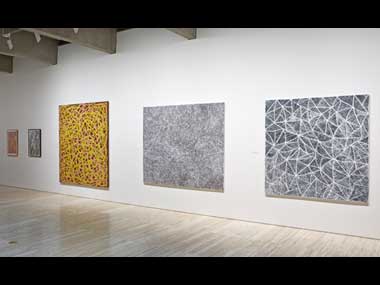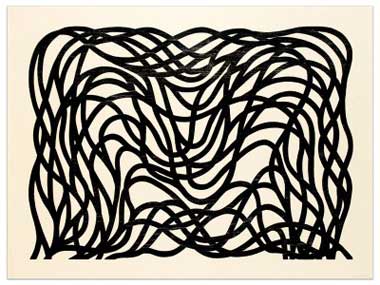SOL AND EMILY

Installation shot showing a wall from the LeWitt Indigenous Collection at AGNSW - that first Kngwarreye work on paper on the far left.
Posted by Jeremy Eccles | 05.03.14
Gallery: Art Gallery of NSW
Dates:
20.02.14
: 03.08.14
People have been trying to force Emily Kngwarreye's art into baskets familiar to Western art aficionados for years – Abstract Expressionism being the favourite. And then along comes Sol LeWitt, the inventor of the term 'conceptual art' – which has allowed many a lesser artist to avoid the fact that they can't paint and don't have an aesthetic bone in their body - who, after both their deaths, has gathered up the innocent Emily and given her 'conceptual' cred as well!
It's all on show at the AGNSW in Sydney – an exhibition derived from the great collection of LeWitt's work that Aussie art magus John Kaldor has accumulated, much of it simply instructions as to how to cover a wall in lines. Early, they were black and white and architectural; later colour came in and a much more organic quality...”openness of heart” is how SMH critic John McDonald describes it. Is it possible that this humanity emerged from his discovery of Kngwarreye?
For, when he was in Sydney for his Museum of Contemporary Art solo show in 1998, the AGNSW was offering an exhibition of Utopia art. “Emily's yarn or Utopia type” hit LeWitt right between the eyes, “since that is what I am doing. They are both beautiful and wonderful. I feel a great affinity for her work and have learned a lot from her work”, he told Kaldor in a fax that's also on display in Sydney. Well, it certainly wasn't the other way around since the great Aboriginal artist had been dead two years by then.
And Kaldor began buying Emily for LeWitt – also Gloria Petyarre – totalling 30 works. Carefully packed and sent to Connecticut, “We were all entranced when the first painting arrived”, LeWitt's American curator is quoted as saying. This 1995 work on paper, 'Untitled' is back in Sydney – bold and chaotic, a gestural collage of brush-strokes that are almost 3D in impact. It reminded me more of Petyarre's later 'Medicine Leaves' works than quintessential Emily, and it seems incredible that LeWitt's quasi-Minimalism could find fellow feeling with it.
But, look across the gallery, and there are works from 2000 and 2001 by LeWitt that could be sophisticated Emilys. 'Irregular Grid' and 'Irregular Loops' may not be a match for 'Awelye' as titles, but 'Tangled Bands' (owned by the fortunate Mrs Kaldor) is all Emily in style, though its opulent gold lustre isn't a colour one could imagine turning up at Soakage Bore, Utopia! “The affinities with the yam root paintings of Emily Kame Kngwarreye are unmistakeable”, declares McDonald.
AGNSW curator Natasha Bullock sums up - “His late gouaches look loose and gestural, but the systematic nature of his process remains”. So LeWitt never attempted to become an Aboriginal artist sufficient to annoy the annoying Richard Bell, who's just noticed that Del Kathryn Barton puts dots all over the background of her totally Western canvases.
But was Emily a conceptualist? For LeWitt, the idea was everything – art that was objective rather than emotional. In his key 1967 essay, 'Paragraphs on Conceptual Art', he talked of the square being “the least emotive of forms”. Not many squares in Kngwarreye! But, when you think about it, the idea – or the story – may well have been more important to her than its aesthetic representation, even though her mastery of colour was arguably a whole lot more developed than LeWitt's. And we're constantly being challenged regarding the sole authorship of Aboriginal artworks by the collaborative involvement of family or skin-affinitive parties helping to finish a painting. LeWitt knew all about collaboration – collaborators flew from Helsinki and Berlin to tackle a massive wall of scrawls over two weeks in the AGNSW.
In the light of the recent idiocy revealed by London critics when faced by Aboriginal art, it's such a joy to find a major international visual voice from the mid-20th Century empathising so instinctively with an Aboriginal master. Why have so few Aussie artists managed to do likewise, I wonder?
And did John Kaldor ever buy Emily for himself, I wonder – or was she never 'so contemporary'???
Share this:
»  del.icio.us
»
del.icio.us
»  Digg it
»
Digg it
»  reddit
»
reddit
»  Google
»
Google
»  StumbleUpon
»
StumbleUpon
»  Technorati
»
Technorati
»  Facebook
Facebook
Contact Details
Gallery: Art Gallery of NSW
Contact: Cara Pinchbeck - Curator of Aboriginal and Torres Strait Islander Art
Email: artmail@ag.nsw.gov.au
Telephone: +61 2 9225 1700 or 1
Address: Art Gallery Road Sydney Sydney 2000 NSW
Gallery: Art Gallery of NSW
Contact: Cara Pinchbeck - Curator of Aboriginal and Torres Strait Islander Art
Email: artmail@ag.nsw.gov.au
Telephone: +61 2 9225 1700 or 1
Address: Art Gallery Road Sydney Sydney 2000 NSW

Sol LeWitt print, 'Loopy Doopy, Black and White' from 2001 from his website
Where is the exhibition?
Further Research
Gallery: Art Gallery of NSW
Artists: Emily Kngwarreye | Gloria Petyarre | Sol LeWitt
News Tags: conceptual art | Emily Kngwarreye | Jeremy Eccles | John Kaldor | Sol LeWitt
News Categories: Australia | Blog | Exhibition | Feature | Industry | News
Exhibition Archive
- 10.10.17 | TARNANTHI 2017
- 11.08.17 | Natsiaas 2017
- 20.07.17 | APY ART DOMINATES THE WYNNE
- 17.07.17 | Anangu Artist Wins $100,000 Prize
- 14.07.17 | The End of AAMU
- 11.07.17 | ART ACROSS THE COUNTRY
- 11.07.17 | TARNANTHI IN OCTOBER
- 05.07.17 | TJUNGUṈUTJA - from having come together
- 13.06.17 | Ghost-Nets Straddle the World
- 07.06.17 | Grayson Perry Going Indigenous?
- 05.06.17 | Barks Bigger than Ben Hur
- 27.05.17 | NGA QUINQUENNIAL 2017
- 21.05.17 | Blak Douglas Finds Home at the NGA
- 21.05.17 | BRIAN ROBINSON WINS HAZELHURST WOP
- 18.05.17 | PARRTJIMA 2.0
Advertising

